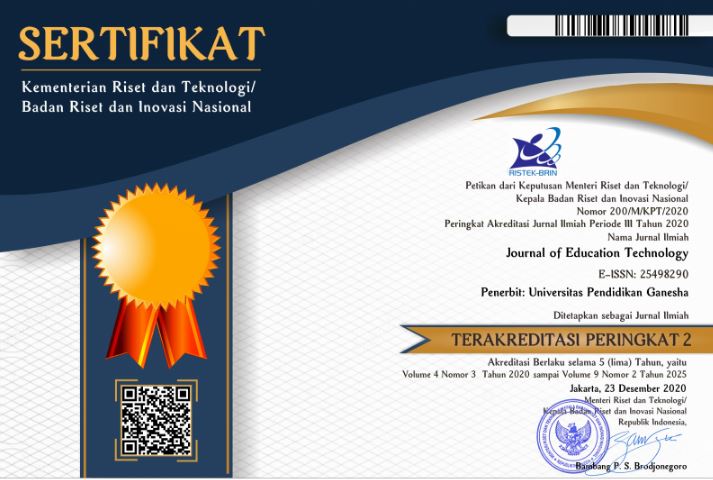PENGEMBANGAN MOBILE LEARNING BERORIENTASI MODEL PEMBELAJARAN FLIPPED CLASSROOM PADA MATA KULIAH MULTIMEDIA
DOI:
https://doi.org/10.23887/jet.v2i1.13808Keywords:
pengembangan, mobile learning, flipped classroom, multimediaAbstract
Penelitian ini merupakan penelitian pengembangan yang tujuan: 1) mengetahui rancang bangun mobile learning berorientasi model pembelajaran flipped classroom pada mata kuliah multimedia Jurusan TP FIP Undiksha, 2) mengetahui kelayakan mobile learning berorientasi model pembelajaran flipped classroom pada mata kuliah multimedia Jurusan TP FIP Undiksha, dan 3) mengetahui keefektifan mobile learning berorientasi model pembelajaran flipped classroom pada mata kuliah multimedia Jurusan TP FIP Undiksha. Subjek coba penelitian ini adalah satu orang ahli isi, satu orang ahli media pada tahapan uji validasi serta 12 mahasiswa Jurusan TP FIP Undiksha semester VIII 2016/2017 pada tahap evaluasi formatif. Pada tahap evaluasi sumatif (uji efektivitas) dipilih mahasiswa Jurusan TP FIP Undiksha Semester VII Tahun Akademik 2017-2018. Instrumen pengumpulan yang digunakan pada penelitian ini adalah angket dan tes hasil belajar. Hasil penelitian pengembangan ini menunjukkan bahwa hasil uji pada masing-masing tahap berada pada kategori baik dan layak digunakan dalam pembelajaran
References
Arief S. Sadiman, et al. (2009). Media pendidikan: pengertian, pengembangan dan pemanfaatannya. Jakarta: Rajawali Pers
Azhar Arsyad. (2009). Media pembelajaran. Jakarta: Rajawali Pers.
Borg, W.R., & Gall, M.D. (1983). Educational research. An introduction (4th ed.) New York: Longman.
Chee, T.S. & Wong. A.F.L. (2003). Teaching and learning with technology. Singapore: Prentice Hall.
Dantes. N. (2014). Desain dan Analisis Eksperimen. Singaraja: PPs Undiksha
Dean N. Shimamoto. 2012. Implementing a Flipped Classroom: An Instructional Module. Hawai Amerika Serikat: Department of Educational Technology University of Hawaii Manoa.
Dick, W. & Carey, L. (2005). The systematic design of instruction (6th ed.). Illinois: Scott, Foresman and Company.
Georgiev, Tsvetozar, Evgeniya Georgieva, Angel Smrikarov. 2005. A General Classification of Mobile Learning Systems, International Conference on Computer Systems and Technologies-CompSysTech’.http://ecet.ecs.ru.acad.bg/cst05/Docs/cp/sIV/IV.14.pdf, Diakses 23 Desember 2016.
Guilford, JP. 1973. Fundamental Statistic in Psychology and Education. Tokyo : Mc Graw-Hill Kogakhusa LTD.
Haryono. 2011. Pengenalan E-learning. Jurnal Dharma Pendidikan. Didownload pada tangal 15 Agustus 2011 dari http://dharmapendidikan.blogspot.com/2011/03/pengenalan-e-learning.html
Herman Dwi Surjono. 2010. Pengembangan Course E-learning Berbasis Moodle. Yogyakarta: UNY Press
Holzinger, Andreas, Alexander Nischelwitzer, dan Matthias Meisenberger. 2005. Mobile Phones as a Challenge for m-Learning:Experiences with the Mobile Learning Engine (MLE) using Mobile Interactive Learning Objects (MILOs). http://dmt.fhjoanneum.at/kd3/objects/application_pdf/percom 2004%20hawaii_PerIL_ah_nis.
Johnson, Graham Brent. 2013. Student Perceptions of The Flipped Classroom. Columbia: The University Of British Columbia.
Jonathan, Bregmann dan Aaron Sams. 2012. Flipp Your Classroom. United States of America: International Society for Technology in Education.
Lee, W.W., & Owens, D.L. 2004. Multimedia Base Instrucion Design: Computer Based Training, Web Based Training, Distance Broadcast Training, Performance Based Solution (2nd ed.). San Fransisco: Pfeiffer A Wiley Imprint.
Luis Tirtasanjaya, Teo Chin Wen, dkk. 2012. Assessing the effectiveness of flipped classroom pedagogy in promoting students’ learning experience. NYGH Research Journal.
Merrill, Paul F., et al. (1996). Computers in eucation (3rd ed.) Englewood Cliffs, NJ: Eucational Technology Publication.
Mustaji. 2012. Desain pembelajaran dengan menggunakan model pembelajaran kolaborasi untuk meningkatkan kemampuan berkolaborasi. [Online]. Tersedia di: http://pasca.tp.ac.id/site/desain-pembelajaran-denganmenggunakan-model-pembelajaran-kolaborasi-untuk-meningkatkankemampuan-berkolaborasi. [Diakses 4 Februari 2014]
Newby, T.J. et al. (2000). Instructional technology for teaching and learning. New Jersey: Prentice-Hall Inc
Nicola Sales. 2013. Flipped the Classroom: Revolutionising Legal Research Training.Cambridge Journals. Vol. 13. Pp 231-235.
Phillips, R. (1997). The developer’s handbook to interactive multimedia: A practical guide for educational applications. London: Kogan Page.
Pierce, Richard EdD and Jeremy Fox, PharmD. 2012. Instructional Design And Assessmentvodcasts And Active-Learning Exercises In A “Flipped Classroom” Model Of A Renal Pharmacotherapy Module. American Journal of Pharmaceutical Education 2012; 76 (10) Article 196.
Purwanto. (2009). Evaluasi Hasil Belajar. Yogyakarta: Pustaka Pelajar
Romi Satria Wahono. 2008. Memilih Sistem E-Learing Berbasis Open Source. Didownload pada tanggal 22 Maret 2013 dari http://romisatriawahono.net/2008/01/24/memilih-sistem-e-learning-berbasis-open-source/
Santyasa, I W. 2006. Metodologi Penelitian Peningkatan Kualitas Pembelajaran (PPKP). Makalah Disajikan dalam Pelatihan Para Dosen Undiksha tentang Penelitian Tindakan Kelas dan Penelitian untuk Peningkatan Kualitas Pembelajaran di Perguruan Tinggi. Singaraja: Nopember
Smaldino, S.E., Lowther, D.L., & Russell, J.D. (2007). Instructional technology and media for learning (9th ed.). New Jersey: Pearson Education, Inc.
Songhaao, H. et. Al. 2011. Evolution From Collaborative Learning to Symbiotic E-learning: Creation of New E-learning Environment for Knowledge Society. US-China Education Review, 8(1), 46-53, Didownload pada tanggal 14 Pebruari 2012 di http://www.eric.ed.gov/PDFS/ED519417.pdf
Sugiyono. (2009). Metode penelitian kuantitatif kualitatif dan R&D. Bandung: Alfabeta
Sukardjo, (2010). Evaluasi Pembelajaran. Buku Pegangan Kuliah: PPs Universitas Negeri Yogyakarta
Yuniati, Lukita. 2011. Pengembangan Media Pembelajaran Mobile Learning Efek Doppler sebagai Alat Bantu dalam Pembelajaran Fisika JP2F. Vol 2 Nomer 2 September 92-101.
Yusufhadi Miarso. (2004). Menyemai benih teknologi pendidikan. Jakarta: Kencana
Downloads
Published
How to Cite
Issue
Section
License
Authors who publish with the Journal of Education Technology agree to the following terms:
- Authors retain copyright and grant the journal the right of first publication with the work simultaneously licensed under a Creative Commons Attribution License (CC BY-SA 4.0) that allows others to share the work with an acknowledgment of the work's authorship and initial publication in this journal.
- Authors are able to enter into separate, additional contractual arrangements for the non-exclusive distribution of the journal's published version of the work (e.g., post it to an institutional repository or publish it in a book), with an acknowledgment of its initial publication in this journal.
- Authors are permitted and encouraged to post their work online (e.g., in institutional repositories or on their website) prior to and during the submission process, as it can lead to productive exchanges, as well as earlier and greater citation of published work. (See The Effect of Open Access)
















